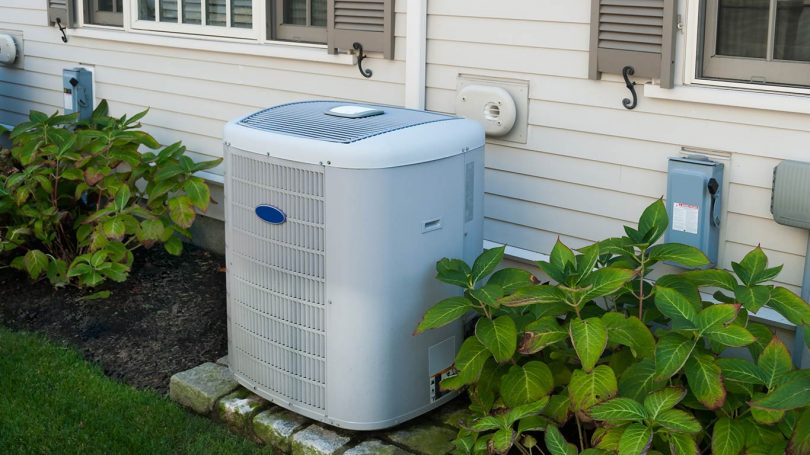Homeowners sometimes may not realize it’s time to replace their heating, ventilation, and air conditioning (HVAC) system until there’s a major issue.
And the condition of the overall system, along with other factors like home size, type of unit, and local climate might impact HVAC replacement cost.
HVAC system cost varies year by year and per individual situation. So understanding cost considerations for different HVAC equipment, types of systems, and everything replacement entails can help you budget and plan for paying for emergency home repairs.
HVAC System Parts
There are several ways to heat and cool a home that falls under the HVAC umbrella. Yet, most HVAC system parts and components can be grouped into the following categories.
Thermostat
Thermostats monitor temperature and can be used to adjust whether a HVAC system heats or cools a building. Generally, the temperature can be set manually or preset to regulate heating and cooling to a desired indoor temperature.
These systems can be connected to the HVAC system through wiring—or Wi-Fi in the case of smart thermostats. More advanced thermostats can be used to enhance comfort and efficiency by controlling temperature settings for multiple zones throughout a home or building.
Heating and Cooling Unit
The heating and cooling unit is the main component of any HVAC system. Common types include furnaces, boilers, heat pumps, and air conditioners.
Furnaces are generally located inside a structure and comprise a heating element powered by gas, oil, or electricity and a blower to circulate heated air through the building.
Boilers are traditionally interior units, too, but circulate hot water or steam to radiators or baseboards located throughout the property.
Air conditioners include condenser units, which are located outside because they produce hot air through the heat transfer process.
Heat pumps also consist of an external condenser, but a key difference is that they can be used to either heat or cool a home. These systems work in conjunction with an indoor blower unit to distribute heated or cooled air.
Filtration
HVAC systems incorporate air filters to remove dust, allergens, and other particles from entering the return-air duct. Usually, air is drawn from multiple locations inside a building to the HVAC system.
Whether filters are the reusable or disposable variety, periodic cleaning or replacement is necessary to maintain optimal performance.
Ultraviolet lights are another option for treating air quality in an HVAC system. Their ability to disinfect the air of mold and pathogens makes them helpful for some homeowners with severe allergies.
Delivery System
Most buildings consist of multiple rooms and may include more than one floor. Distributing heated and cooled air throughout the space requires a system of ductwork and vents.
Many HVAC systems utilize separate supply and return ducts to circulate, filter, and treat air continuously. Supply ducts bring air from the heating and cooling unit to blowers and vents to heat or cool an area.
Meanwhile, return ducts transport untreated air back to the HVAC system.
Exhaust Outlet
Any HVAC system that involves combustion—burning oil, gas, or wood—will need an exhaust outlet to expel harmful fumes out of the building. An exhaust outlet can be its own vent or be connected to an existing chimney.
HVAC System Cost Estimates
The type of unit chosen for replacement is a key determinant of cost. Prices may fluctuate whether a full or partial replacement is needed and based on technological advances in HVAC efficiency.
Cost estimates below account for the HVAC unit, any system parts, installation, and removal of old equipment.
Boilers
Boilers have been used to heat buildings for more than a century and are found in homes and commercial buildings alike. The average replacement cost can range between $4,000 and $7,500 depending on the type of boiler.
HVAC replacement cost for boilers can be higher if fuel tanks, piping, and gas hookup need to be repaired or installed.
Heat Pumps
Despite their name, heat pumps actually can be used to both heat and cool a building. These electric HVAC systems pull heat from outdoor air to heat a building even during cold weather conditions.
When it’s warm out, heat pumps cool buildings by drawing heat from indoor air and expelling it outside.
Depending on the type of heat pump and size of the system (measured in tons), costs average between $4,100 and $7,200.
Air-source heat pumps typically run on the cheaper end of the heat pump spectrum. Whereas ground source heat pumps (often called geothermal heat pumps) can cost between $6,000 and $20,000.
Although the upfront cost is significant, lower utility bills and 50-year equipment lifespan could see a return on investment in the long-run.
Central Air Conditioners
Central air conditioners work by drawing moisture from the air inside a building and returning cooled air throughout the structure via ductwork. The system usually consists of one unit located outside but near the structure.
The average cost for installing central air is between $3,800 and $7,500. Prices may be lower for 2-ton or smaller systems, while costs can creep higher if a building requires a 5-ton unit.
Besides the unit itself, the total footage of ductwork to be installed or replaced is a significant cost consideration.
Furnaces
The cost to buy and install a furnace can vary by energy type, total ductwork needed, and the model. On average, prices for replacing a furnace range from $2,000 to $7,000.
Furnaces that run on natural gas or electricity tend to be cheaper to replace than oil-fueled systems.
The total area that will be heated and how well a building is insulated are other factors that will affect the size of the system and potentially increase the cost.
Other HVAC Replacement Cost Factors
When evaluating HVAC options, the type of system is only part of the equation for determining the final price tag. There are many other factors that can affect how much an HVAC replacement will cost.
Local Climate
The popular real estate mantra, “location, location, location”, rings true for HVAC systems too. Whether you live in a cold, warm, or temperate climate will have implications for how an HVAC system is designed.
Property owners in warmer climates could face higher prices for replacing air conditioning units since greater capacity is needed. Meanwhile, costs for furnaces can be higher in more frigid regions where heating efficiency is more important.
Building Characteristics
The size, layout, and condition of a building can play a role in HVAC replacement cost.
Excluding geographic influences, larger structures generally require a more substantial HVAC system to match. The total square footage can impact the price for filtration, ductwork, vents, and zones throughout a building.
A home’s design could also affect how much you’ll pay for HVAC installation. More difficult jobs can add additional labor hours and drive up the cost.
Some possible complications to consider are the ease of accessing components ductwork and whether building renovations will be needed to accommodate new HVAC equipment.
Unit Efficiency
The operational efficiency of a new system is another factor of HVAC replacement cost. Although more efficient units are generally more expensive upfront, they can recoup long-term savings through lower energy bills.
There are different units to calculate energy efficiency per HVAC system. For air conditioners, the Seasonal Energy Efficiency Ratio (SEER) provides a ranking between 13 and 24.
Meanwhile, the Annual Fuel Utilization Efficiency (AFUE) shows how efficient a furnace or boiler runs. In both cases, the higher the score, the greater the efficiency.
While browsing models, keep an eye out for an ENERGY STAR® label to identify the highest-performing HVAC systems. To become certified, this equipment has been vetted by the Environmental Protection Agency and Department of Energy.
For instance, air conditioner models that achieve efficiency scores in the top 25 percent among competitors are eligible for ENERGY STAR® certification.
Paying for HVAC Replacement
The upfront cost of paying for HVAC replacement can be steep. If covering expenses with cash and savings alone isn’t feasible, there may be other ways to pay for these home improvements.
The HVAC unit cost for more environmentally friendly technologies, such as ground source and air source heat pumps, may be eligible for rebates and tax incentives.
For example, homeowners who install a geothermal heat pump can claim a tax credit of 26% of the cost of the equipment if installed during 2020 through 2022 22% of the cost as a tax credit if installed during 2023.
The Takeaway
Even before major components or an entire system needs to be replaced, poor efficiency might increase utility bills. Staying on top of maintenance and knowing the heating and cooling unit’s estimated lifespan could help save money and keep a system running smoothly.
If replacement is necessary for your HVAC system, you may still have a sizable sum to pay after claiming tax credits or manufacturers’ rebates you might qualify for.
Instead of maxing out credit cards or dipping into a retirement account, a personal loan may be able to help with HVAC replacement costs.
A home improvement loan is another option to consider. SoFi offers unsecured home improvement loans, personal loans that don’t require collateral (as secured loans do). An example of a secured loan is a traditional home equity line of credit (HELOC), which uses the equity in the home as collateral.
This article originally appeared on SoFi.








